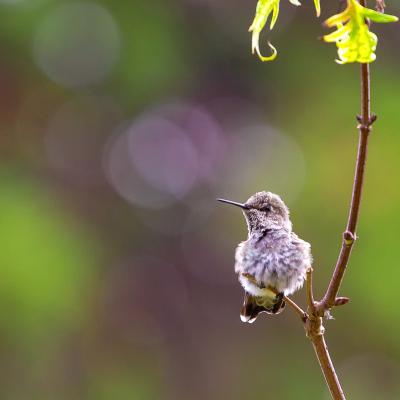- Tags:
- Wildlife,
- Something Wild

Chris Martin, Dave Anderson, and Sy Montgomery talk during their visit. (Photo: Zoe Knox, NHPR)
“I am one of the lightest birds in the sky, yet I am also one of the fastest. I am tiny, but I can fly a very long way. I am mostly made of air, like a bubble wrapped in feathers. Yet I am super strong. I'm only a little hummingbird, but I can do things no other bird can.”
~ An excerpt from New Hampshire author and naturalist Sy Montgomery’s children’s book, “Brave Baby Hummingbird”

Recently, the Something Wild team traveled to Hancock, New Hampshire, to spend time with Sy Montgomery, chatting with her about the animals she loves. This is the second in our series, “A glimpse into the heart, soul, and science of animals with Sy Montgomery.”
We recommend listening to this audio postcard to get a peek into Sy's experiences raising orphaned hummingbirds. We hope to convey how special it is to spend time with Sy and to hear about her friends in the natural world.
Her admiration for hummingbirds is evident: "They're the lightest birds in the sky. They're just full of air — they're just a bunch of lungs. They're like most birds; their feathers are hollow, their bones are hollow."
"They are these tiny little things, and yet they're amazingly strong. And they have all these abilities no other bird has. But what could be more pathetically vulnerable than an orphaned baby hummingbird?".
“They hatch out of eggs the size of navy beans, and they are the size of bumblebees, so they are tiny,” she says, describing the two orphaned hummingbirds she raised with guidance from a friend, a veteran hummingbird rehabilitator.
“And these little guys, when I met them, were just starting to get some feathers. Their eyes had opened. We had to feed them by syringe. And the danger, of course, if you don't feed them enough, they will starve. But if you feed them too much, they will pop.”
The food in your hummingbird feeder is sugar and water, but as they grow, hummingbirds need more protein and other nutrients. “People don't realize that they don't just drink sugar, but that they need hundreds of bugs every day," she says.
"We had to gather all of these bugs in the morning. Little tiny gnats and things, and mush them with a mortar and pestle after we froze them in the freezer,” says Sy. “So mom has to go off and find 500 bugs to throw up into the mouth.”
It’s a complex task, feeding the birds consistently throughout the day. “We would have to feed them every 40 minutes…exactly the right thing, exactly the right amount, at exactly the right time. All day, all the time. Except at night. They do sleep at night.”
Of course, if you are successful, the hummingbirds will eventually leave you. “And then they start flying around the yard,” says Sy. “Then one day they disappeared. They headed for Mexico."
"I am agog at the ability of this tiny bird to make that enormous migration. There's several species of hummingbirds and they only live in North and South America. They don't live anywhere else. They're super fast. They are, for their size, faster than the space shuttle in terms of body lengths per second that they can travel.”
“Brave Baby Hummingbird,” concentrates less on Sy’s journey helping to raise the hummingbirds, and more on their journey south. “They were flying to Mexico, going there without the guidance of anybody,” she says.
“And, you know, the kind of message that I think kids will get, besides the important natural history part, is here's a pathetically vulnerable critter even more vulnerable than they are in the wild because he's needing rescue. He's an orphan,” she says.
“But look at what you can do,” she exclaims. “You know, they become such heroes, the hero's journey that they make. And it says, you can be small and you can be mighty. And sometimes, your vulnerability is what gives you your powers.”
You can be a part of this hero's journey yourself. In these months when ruby-throated hummingbirds are in New Hampshire, you can do your part by maintaining your hummingbird feeder.
You can also plant native plants with red, tubular-shaped flowers that attract hummingbirds to feed, like scarlet bee balm, cardinal flower, Eastern red columbine, and petunias.
Try to refrain from using pesticides to kill bugs, keeping in mind the daily tally of bugs needed to feed baby hummingbirds (as well as other creatures).
And read Sy Montgomery's “Brave Baby Hummingbird” with a child. One of the chapters in Sy Montgomery’s book “Birdology” became the standalone book “The Hummingbirds' Gift,” which in turn inspired “Brave Baby Hummingbird.”
In our next episode in this series, “A glimpse into the heart, soul, and science of animals with Sy Montgomery," we visit with Matt Patterson, a turtle enthusiast and illustrator of some of her books. Matt is host to Fire Chief, a 42-lb snapping turtle who was hit by a car. The pair have worked together on turtle physical therapy, even constructing a turtle wheelchair.
Something Wild is a partnership of the Forest Society, New Hampshire Audubon, and NHPR.
